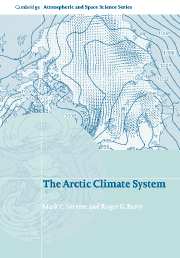Book contents
- Frontmatter
- Contents
- Preface page
- Acknowledgements
- List of Abbreviations
- 1 The evolution of knowledge about the Arctic and its climate
- 2 Physical characteristics and basic climatic features
- 3 The basic atmospheric heat budget
- 4 The atmospheric circulation
- 5 The surface energy budget
- 6 Precipitation, net precipitation and river discharge
- 7 Arctic ocean–sea ice–climate interactions
- 8 Climate regimes of the arctic
- 9 Modeling the arctic climate system
- 10 Arctic paleoclimates
- 11 Recent climate variability, trends and the future
- References
- List of selected websites
- Index
- Plate Section
2 - Physical characteristics and basic climatic features
Published online by Cambridge University Press: 10 August 2009
- Frontmatter
- Contents
- Preface page
- Acknowledgements
- List of Abbreviations
- 1 The evolution of knowledge about the Arctic and its climate
- 2 Physical characteristics and basic climatic features
- 3 The basic atmospheric heat budget
- 4 The atmospheric circulation
- 5 The surface energy budget
- 6 Precipitation, net precipitation and river discharge
- 7 Arctic ocean–sea ice–climate interactions
- 8 Climate regimes of the arctic
- 9 Modeling the arctic climate system
- 10 Arctic paleoclimates
- 11 Recent climate variability, trends and the future
- References
- List of selected websites
- Index
- Plate Section
Summary
Overview
The Arctic climate system is characterized by its low thermal energy state and intimate couplings between the atmosphere, ocean and land. This makes the Arctic a challenging and fascinating region to study. But given the complex nature of the Arctic climate system, where does one start in describing it? A basic foundation is needed, provided in the present chapter through an overview of some of the basic physical characteristics of the Arctic.
The most formal definition of the Arctic is the region north of the Arctic Circle (66.5° N). When defined in this way, the most fundamental characteristic of the Arctic is 24-hour daylight in summer and 24-hour darkness during winter, the number of days with these two extremes increasing with latitude. Figure 2.1 shows the changes in day length with latitude and time of year. For the extreme case of the North Pole, the Sun is above the horizon for six months between the spring and autumn equinoxes and below the horizon for the remaining six months. In more common usage, the Arctic does not have strict geographical boundaries. Arctic conditions (e.g., extreme winter cold or the presence of permafrost) may be found well south of the Arctic Circle. The terms Arctic and North Polar Region are often used interchangeably.
The geography of the North Polar Region is in striking contrast to its southern counterpart.
- Type
- Chapter
- Information
- The Arctic Climate System , pp. 17 - 54Publisher: Cambridge University PressPrint publication year: 2005
- 1
- Cited by



